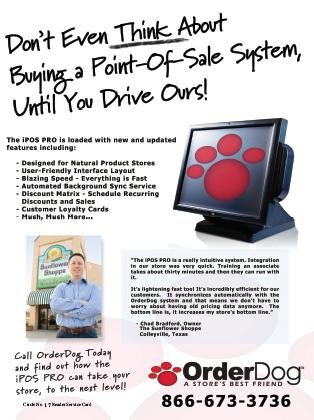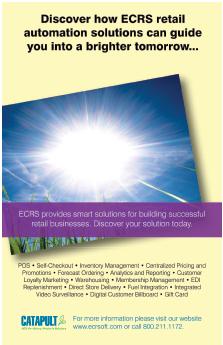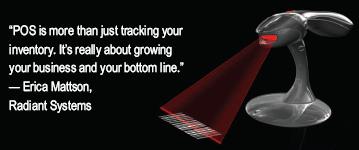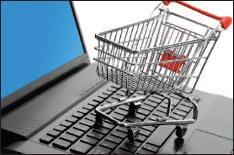If your cash register is a glorified calculator and your Web site has been stagnant for the past year, you are probably missing out on some important opportunities for reaching customers.
I know. Implementing new technology can be a daunting task. But the fact of the matter is that electronic solutions are more sophisticated than ever before, while at the same time being more user-friendly than were previous-generation technology. What’s more, tons of options are available.
Says Bill Schneider, senior product director at Aisle7, Portland, OR, “Technology has come a long way over the past few years, and with that brings new opportunities to share information within the retail environment.”
Investigating electronic point-of-sale (POS) technology, Web design tools and social media opportunities will be well worth your time. Good e-solutions give retailers seamless ways to manage their stores and offer great strategies for reaching new shoppers and keeping old ones satisfied.
You know what that means? “The big keyword to go along with all that is increased sales,” says Erica Mattson, marketing manager at Radiant Systems, Alpharetta, GA.
Should You Make the Switch?
Plenty of stores have made do without fancy POS systems for years. Their well-oiled processes (complete with meticulously kept spreadsheets) are impressive. There’s nothing wrong with these methods, but one cannot go forth bravely into the next level of retailing without at least considering how a fully electronic system can help improve the way you manage your store. It can, says Richard MacKillop, co-founder and CEO of OrderDog, Inc., Carrollton, TX, “help retailers analyze their businesses in ways they’ve never been able to do before. They typically relied on instinct or pen and paper, but there are so many changes that occur on a regular basis that it helps for them to take advance of electronic tools and be more efficient with their time and energy.”
Improved customer service. For starters, systems can more easily track customer loyalty programs, which “add value to customers’ shopping experience,” says Robert Symmonds, president of Auto-Star Compusystems Inc., Medicine Hat, AB, Canada, supplier of POS and retail management solutions.
For instance, many e-solutions allow retailers to set up custom programs. You can choose to let certain purchases add up to coupons or gift certificates, redeemable only during your slowest day of the week, for instance.
Some e-systems also let retailers collect and track information like customers’ birthdays or sales history for your use for targeted promotions. Says Andee Williamson, marketing manager at Radiant Systems, “We keep the complete ticket history [such as who bought what items, when the purchase was made and how much was spent].” You can sort through your data to find customers that have shopped in the grocery department but not in supplements, for example. And then, you can contact them with targeted information, special promotions, coupons or invitations to educational events.
Any retailer knows that speed and accuracy at checkout are important for securing sales (and repeat purchases). Who wants to wait in line, and then argue with a cashier about whether a product should have rung up on sale? “With an electronic POS, customers will also appreciate a faster and more accurate checkout experience,” says Symmonds.
Otis Flieth, vice president of sales at ECR Software Co., Boone, NC, adds another element: less time at checkout means your staff will be free to interact with customers one-on-one in the aisles. Plus, a good system will enable you to look up product prices and availability with ease.
Flieth brings up another time-saver: self-checkout kiosks. The installation of this technology is a growing trend, he feels. “The smaller frame also allows stores to place the kiosk in specialized store departments, allowing the cashier to walk the floor, providing customer service instead of being stationed behind a checkout lane,” he states.
All eyes on this next benefit (even if you already have an e-checkout solution): improved up-selling. Some systems can be programmed to give special alerts to cashiers at checkout. Says Mattson, “No single clerk is going to be able to remember every little thing about every bottle of supplements, especially if you have part-time or seasonal help.”
For instance, you can program ePOS systems to indicate that when Product A is out of stock, clerks should recommend Product B. Or, suggest companion products such as alerting a shopper who just bought a cold/flu product that you also sell natural lozenges.
Another innovative way to program the system is with product warnings. For instance, one popular joint support supplement suggests that the dosage be split during the day and taken with a meal. And, you should work up to the full dose to prevent stomach discomfort. Reminding a clerk to tell shoppers about this at checkout would ensure shoppers have a good experience with the product (and possibly purchase it again). “It gives you that extra boost of customer service that you’re not going to be able to do on your own,” says Mattson.
And how’s this for anoth er perk: some systems can even alert you if an employee fails to open your store in the morning. Speaking of her company’s new Smart Alerts technology, Mattson says, “Let’s say you have a part-time person opening your store at 10:00, and he gets there at 10:15, we’ll send an alert to your cell phone that says no one has signed into the system yet.” This kind of technology can be especially important if you manage more than one retail location. “It’s kind of your eyes and ears of your store,” she says. “You cannot be everywhere at once.”
er perk: some systems can even alert you if an employee fails to open your store in the morning. Speaking of her company’s new Smart Alerts technology, Mattson says, “Let’s say you have a part-time person opening your store at 10:00, and he gets there at 10:15, we’ll send an alert to your cell phone that says no one has signed into the system yet.” This kind of technology can be especially important if you manage more than one retail location. “It’s kind of your eyes and ears of your store,” she says. “You cannot be everywhere at once.”
Innovation is not only happening on the software side; hardware providers are constantly pushing the innovation envelope. “Touchscreens are still the most convenient and interactive ways to engage shoppers in the store,” Schneider says, adding that next-generation solutions include smaller, at-shelf screens “to deliver product information right at the point-of-decision.”
This kind of technology points to a new way of thinking about in-aisle customer service. Says Schneider, “New tablet devices, like the iPad and others, allow staff members to answer questions with confidence right in the aisle.”
Tracking inventory. It’s no easy task to know exactly which products to order, when and how much—without surplus or shortfalls. But, a good e-solution can help. “Getting the right reports is important so you can arrive at the best conclusions and order the right amount of inventory,” says Williamson.
Some systems offer hand-held data collection devices, making inventory management and reordering as easy as scanning products in your store. Within a week of moving to an electronic inventory system, says MacKillop, time spent on inventory is dramatically reduced.
Symmonds notes that his company’s systems will suggest how many and what to order and will let retailers calculate purchase orders based on inventory that was sold in a specified time period. This not only saves time; it can add up to extra cash in your drawer. “Systems can reduce inventory costs significantly by ensuring the right products are stocked at the right time,” says Symmonds.
Having this information on hand has another advantage: you’ll know exactly which products are your most and least profitable. Says Williamson, “That gives you a lot of leverage when you go back to the vendor to negotiate better pricing.”
In agreement is Symmonds, who states, “Detailed sales reports offer retailers the tools necessary to analyze their businesses. Retailers can make informed business decisions with insight into profit, inventory and top-selling products.”
MacKillop offers another interesting element. Retailers that want to take advantage of electronic order management don’t need to be techies to do so (or even have a computer, in some cases). We have systems intended for those who have never used a computer or a mouse, to those who have sophisticated, wireless handheld computers, he says.” In the works at OrderDog is a new scanner that can collect orders across multiple vendors, view information onscreen, transmit information and download updates via phone lines as opposed to the Internet. This solution benefits stores that want to replace old MSI machines from distributors without a computer. “This is the first real viable replacement for that,” says MacKillop.
Risk management. Let’s talk about something no store owner wants to hear: you may have untrustworthy employees in your midst. With an electronic system, you can track who is doing what at checkout. For instance, some systems will send you an alert (such as to your cell phone or e-mail account) if a cashier has done too many voids or returns during a certain period of time.
Having such information before you do your inventory will help you protect yourself. “You can be proactive about it and not wait until you don’t have any money,” says Williamson.
Also speaking on the point of security is Symmonds, who states that one can avoid credit card fraud with a good electronic system. “Payment security is becoming an increasing concern for retailers. As credit card fraud continues to increase, ensuring that your customers’ credit card data is kept secure is essential,” he states.
He explains that some systems are built with Payment Card Industry (PCI) compliance in mind. Such standards include requirements for security management, policies, procedures, network architecture, software design and other critical protective measures. “It is absolutely critical that retailers choose software that meets these data security requirements,” Symmonds says.
Go green. Another interesting reason why retailers are choosing electronic POS systems is that they help stores be more green. Inventory and ordering is done with a scanner rather than pen and paper. And, some systems enable you to e-mail sales receipts rather than printing them. Not only is this greener, but it’s also a “great way to get a person’s e-mail address without seeming too invasive,” says Williamson.
New POS terminals also use less energy than older equipment, says Flieth. POS printers, he says, now come with environmentally friendly options, too, that use less paper and energy. “The new trend in POS terminals also seems to be moving toward an all-in-one unit, meaning, there is no separate central processing unit. This allows retailers to maximize space and offer a more appealing overall appearance,” Flieth explains.
Integrated tools. Many companies interviewed for this article indicated they offer all-in-one technologies, which means that several e-solutions are integrated together. Such systems may be composed of POS, inventory and order management, payment processing, hand-held ordering devices, e-commerce (such as tools for managing a Web site), e-mail marketing tools, shelf labeling, customer loyalty programs and more. Often, customization of these tools is an option, too.
The integrative approach has several benefits to retailers. First, it makes the switch much easier for those who are new to the technology. Says Mattson, “People want an all-in-one solution, especially those who are apprehensive of technology or are afraid of managing six or seven different vendors—that’s six or seven different technologies you’re going to have to adapt to.”

A seamless, all-in-one system also eliminates the blame game if something goes wrong down the road. Mattson sets up this scenario: “Your credit card processor
doesn’t work, so you call the credit card processor. They say it’s not a problem with their system; it’s your software. So, you call the software company, who says, no, it’s not us. If you have one person to call, it solves a lot of problems.”
Another aspect of integration could be easy use of e-commerce solutions. In this economy, many retailers are looking for new ways to increase sales and online stores are becoming more and more important. “It’s growing,” says Mattson. “Sometimes, even if you’re not selling a lot of things online, it’s driving traffic to your brick and mortar store. People are going online to search for stores, they’ll find your Web site, and then visit your store.”
Getting Tangled in the World Wide Web
No matter what kind of store you own, it’s important to have some sort of Web presence. Many customers, especially those of younger generations, feel a good Web site legitimizes a business. Don’t be left in the dust without a great Web site. “Fortunately, there are plenty of inexpensive, yet powerful options” for building a site, says Schneider.
Again, some e-retail management solutions offer easy tools for creating Web sites. If yours doesn’t, there are several free online content management tools for building Web sites with little to no experience. But, Linda O’Hara, vice president and co-founder of Living Naturally, Sarasota, FL, offers a warning: “A Web site is only as good as its technology and its content.” Since limitless technology platforms are available, “retailers need to choose technology providers that complement their level of knowledge and understanding, and can offer technology, content and technical support in one package,” she says.
O’Hara also makes the point that simply establishing a site will not make consumer traffic “magically appear.” In order to have a successful site, she offers these suggestions:
• “Look honestly at your business and staff and determine realistic goals and objectives for the Web site.
• Choose staff members that are comfortable with online media to be responsible for maintaining content on your Web site.
• Focus your Web site content on your store and your community and emphasize your unique services.
• Update your content no less than once a week. Content that hasn’t been updated in a month is too long in today’s market.
• Make sure you use e-mail to communicate with customers with offers and promotions that link back to your Web site.
• Think carefully about jumping into e-commerce. Some 98% of business is multi-channel; use your Web site to drive traffic to your store.
• What forms of social networking do you feel are most appropriate for retailers? Ho w can they use these tools to connect with shoppers? And, how often should retailers issue updates to followers?”
w can they use these tools to connect with shoppers? And, how often should retailers issue updates to followers?”
Once you have a site, you can also offer important health and wellness content. “The Web has become the go-to place for consumers to learn about health and wellness issues,” says Schneider. “Over 60% of consumers search for wellness issues every month online. As champions of health and wellness products as well as issues such as sustainability, we are seeing natural products retailers serving the role as local champion on these key topics.”
He notes that his company offers Aisle7 ONLINE, through which consumers can find informtion on 200 health concerns and over 450 related supplements.
Educational tools, such as those from Living Naturally and Aisle7, encourage sales in unique ways. Posting budget-friendly recipes, for instance and recipes that meet special dietary concerns can help “give shoppers ideas on how they can access your store and meet their health and wellness goals,” says Schneider.
|
Years ago, you may have invested in an electronic retail management system. While it may seem like just yesterday, if it was more than seven years ago, it might be time for an upgrade. This is the average length most stores go before they need to freshen up their tools. |
O’Hara says that while such communication is not as private as it is with traditional marketing, “business use of these platforms is growing rapidly, which may change the fundamental nature of these media from a consumer-to-consumer orientation to a business-to-consumer orientation.”
If you’d like to dip a toe in the social media waters, here are some tips from Schneider for how to use social media sites:
• Feature news and other educational material.
• Advertise promotions.
• Post answers to frequently asked questions.
• Drive traffic to a recipe bank posted on your Web site, and let fans comment on how they liked the recipe.
• Talk up store events and hot new items.
• Encourage fans to visit your Web site to read educational articles.
• Try using plug-ins (like Clearspring) to share content across other social services associated with your store.
Using social media for marketing is indicative of a paradigm shift in retailing. Advertising one’s store is less one way (“Let me tell you what I offer) and more interactive (“Let me answer your questions and hear your suggestions”).
According to Schneider, the end result is a more natural form of communication—especially for natural products stores that focus on being an active part of the community. “Local retailers are so community focused they are in prime position to put on their community-building hats and leverage the new social tools to extend the dialogue beyond their store into the online medium,” he says.
One last key to social media success is to post several times a day. “Retailers should adjust their frequency of communication to the subject and the media. Twitter feeds might be posted daily; Facebook may also be posted daily or weekly,” states O’Hara, also reminding us that e-mail is a key communication tool, too.
More posts aren’t always better, though. “You have to be relevant and add value. That’s why we believe retailers that mix a combination of suggestions with health tips and food advice are the most successful,” Schneider says. WF
Published in WholeFoods Magazine, July 2010 (published online ahead of print, June 21, 2010)


 The Best Time to Upgrade Your System
The Best Time to Upgrade Your System







